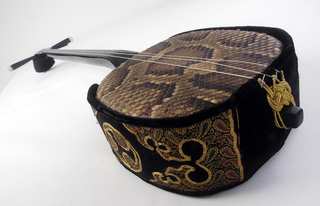Sanshin
Spike box lute (321.312-5-6). It derives from the Chinese sanxian, introduced ca. 1390 in the Okinawa archipelago, centre of the ancient Ryukyu kingdom. As its predecessor, it has a long narrow fretless handle which is followed by a spike that crosses the rectangular soundbox. This has a back and soundboard made of a snake skin — usually a python — that covers the wooden ribs. The number of simple courses (Japanese san = three, shin = string) gives name to this lute. The strings are usually plucked with a horn plectrum worn on the right-hand index. During the 16th c. the sanshin spread over the rest of Japan and gave origin to the shamisen. Nowadays, it is the most important instrument for folk and classical music in the Okinawa and Amani archipelagos. It is played alone or in different bands, accompanying songs and dances. In Okinawa, the court vocal music — uta-sanshin — has been named after this instrument. L. 76.5 x w. 15.5 x h. of the sanshin 7 cm. L. of the plectrum 1.8 cm. Gift, Shigeturu Kamiya (its maker), 1976. IM 621.







